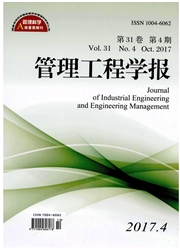

 中文摘要:
中文摘要:
针对协同产品开发项目的动态性、不确定性和复杂性的特点,首先对该过程中的任务类型及其特征进行了详细的说明,并提出了协同产品开发过程中的动态任务选择问题;其次,提出了基于设计主体主观偏好的动态任务选择方法,该方法考虑了设计主体的偏好:性格偏好与工作量偏好,以及任务的客观属性:重要度、紧急度和匹配度,从而在保证关键任务优先执行的同时,充分体现协同产品开发过程中设计主体的自主性、主动性和协作性;最后,对比仿真实验的结果表明,本文提出的方法能够有效地缩短产品开发周期,并能够清晰描述设计主体在过程中的动态任务选择行为过程。
 英文摘要:
英文摘要:
As the advanced development mode, collaborative product development has played a significant role for improving product competitiveness in recent years. To shorten the market cycle of new products, decrease design cost and improve innovation degree, collaborative product development emphasizes on the collaboration of various professional fields, departments or enterprises. However, collaboration is the challenge for dynamic management of product development process. Specifically, there are four significant characteristics of collaborative product development process: dynamic, uncertainty, distribution and collaboration. Simultaneously, in collaborative product development projects designers have more autonomy and initiatives compared to members in other engineering projects. Thus, considering designers' preference can not only emphasize on designers' predominance in collaborative product development process,but also describe the process generally, efficiently and veritably. It is important to provide a scientific basis for process management and optimization. Aimed at dynamic task selection problems in collaborative product development process, this paper proposed a preference-based method which considers objective attributes of tasks simultaneously. In this proposal, designers' preference includes character preference and workload preference. Character preference describes various designers' preference on various types of tasks by mainly including independent and collaborative processes. Independent designer uses the collaborative process to execute temporary collaboration tasks. Workload preference shows that the working habit of designers can be classified into 2 types: long-term preference and short-term preference. Long-term preference means that designers incline to perform long-term tasks firstly and then short-term tasks, whereas short-term preference means short-term tasks has higher priority in the selection process. Objective attributes of task include task importance, task urgency and ma
 同期刊论文项目
同期刊论文项目
 同项目期刊论文
同项目期刊论文
 A human-oriented simulation approach for labor assignment flexibility in changeover processes of man
A human-oriented simulation approach for labor assignment flexibility in changeover processes of man Modelling and simulation of the task scheduling behavior in collaborative product development proces
Modelling and simulation of the task scheduling behavior in collaborative product development proces Static scheduling in consideration of resource categories in collaborative product development proje
Static scheduling in consideration of resource categories in collaborative product development proje 期刊信息
期刊信息
